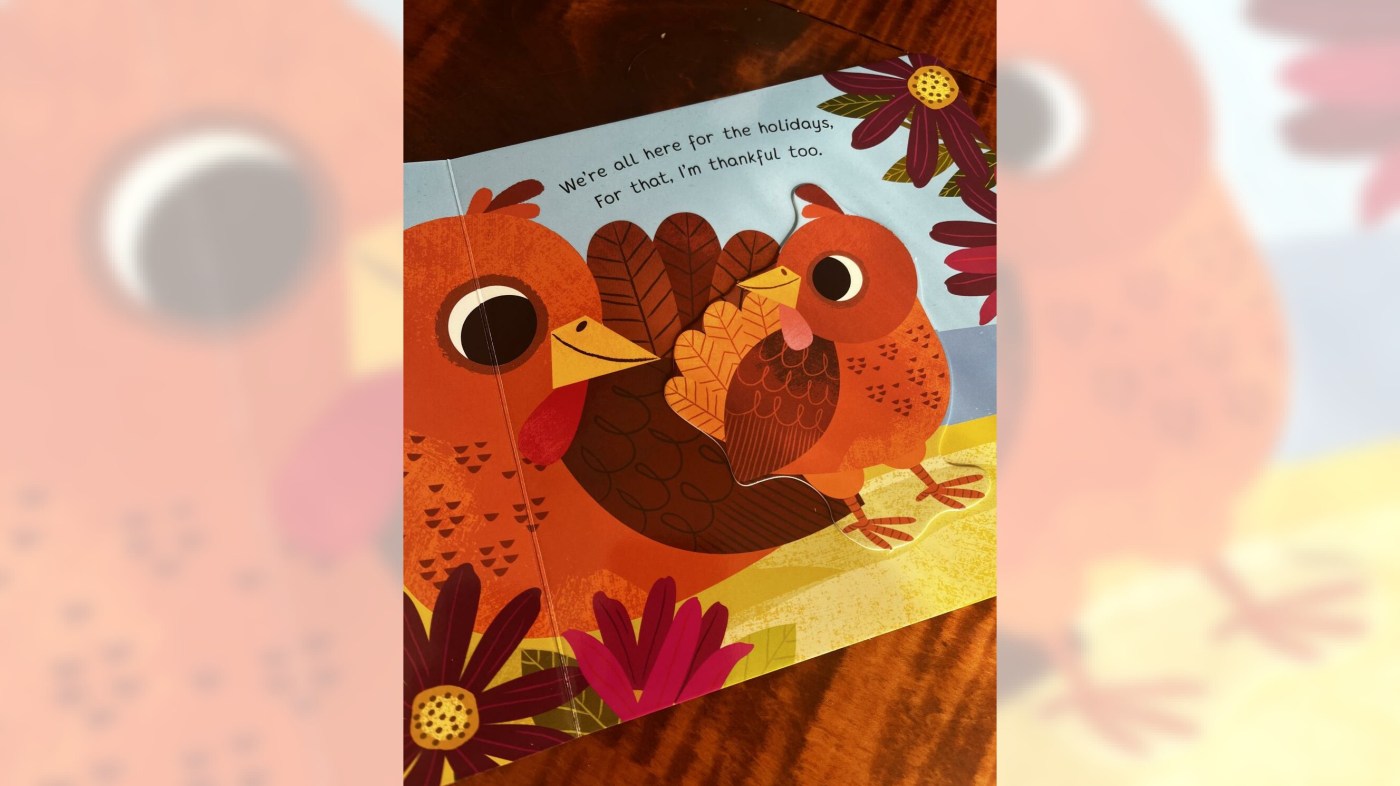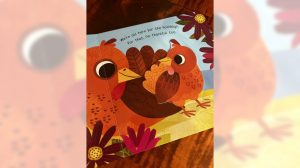
Gifts for young readers: Books that teach kids about gratitude
These books aren’t all directly about gratitude. But they all offer a chance to chat or think about appreciating another person’s effort, gifts or generosity.
These books can also help build empathy by reminding kids how nice it feels to be appreciated.
They can help children understand that resources like food and time are limited, so they shouldn’t be wasted or taken for granted.
And some of these books have a message that life’s best gifts can’t be simply bought or sold.
‘Sylvester and the Magic Pebble,’ written and illustrated by William Steig
Little donkey Sylvester Duncan finds a magic pebble and makes a wish. He starts to imagine all the other things he could wish for — to help himself, his family, even everyone. Then a lion walks over, and things go horribly wrong. Steig’s ingenious plot, mighty prose and delicate drawings offer a witty lesson in counting blessings and appreciating good health and time with loved ones.
Gratitude tie-in: What’s the difference between a want and a need? And the end of the story, why did the family decide to keep the pebble out of reach?
Discussion idea for older children: This is a fable for all ages. One talking point, of many possible: Sometimes, the best way to figure out the value of something — and to appreciate it — is to lose it. Have you ever felt that way?
‘You’re My Little Cutie Pie,’ written by Nicola Edwards and illustrated by Natalie Marshall
First came “You’re My Little Cuddle Bug,” whose feel-good message, simple rhymes, touchable pages and adorable pictures gave millions of children a chance to snuggle up with the readers who love them. Then came the “You’re My Little” series, with books about Halloween, Hanukkah, Independence Day and more. New kid on the block: Thanksgiving themed “You’re My Little Cutie Pie,” published in September, which fosters appreciation between reader and child. Sample line: “You’re my little thankful friend, I’m glad that I have you. / We’re all here for the holidays, For that I’m thankful too.” Bonus: It’s published by San Diego-based Silver Dolphin Books.
Gratitude tie-in: This book is an opportunity to model gratitude — in this case, from the parent or older reader who is celebrating and appreciating the child.
Discussion idea for older children: Reading or being read a board book might be a tough sell for an older kid, but here’s a twist that could work for some families: ask an older sibling to read it to a younger one.
‘What I Like About You!,’ written by Marilynn James and illustrated by Miki Yamamoto
There’s a big message wrapped in this little board book: The same things you might like about your friends are the very things they probably like about you. Like kindness, silliness, encouraging someone through a tough spot, having common interests and sharing. With sweet illustrations, a rhyme scheme and a cool surprise on the last page, this is an engaging and lively read for and with kids under 6 or so.
Gratitude tie-in: There are lots of things that make someone a good friend. You can thank your friends and tell them why you think they’re great.
Discussion idea for older children: If any big siblings are listening in (or pick up the book on their own) here’s a higher level message: What qualities make a good friend? Is it about their words, behavior, shared interests, or something else? How can you protect yourself from imbalanced friendships or social relationships?
‘Giraffes Can’t Dance,’ written by Giles Andreae and illustrated by Guy Parker-Rees
This whimsical picture book is a story about being true to oneself. A lanky giraffe named Gerald decides to join a jungle dance contest. Everyone who dances before him is phenomenal. Then it’s Gerald’s turn. Spoiler: He’s not a great dancer, and the other animals let him know how ridiculous they think he is. Gerald loses confidence. But wise words from another critter help him find the courage to try again. Gerald ends up being an inspiration to the other animals, through his unique style of dancing — and acceptance of what makes him an individual.
Gratitude tie-in: Recognize and be grateful for the gifts you have, even if others don’t appreciate them.
Discussion idea for older children: Gerald was looking for external validation for his dance moves, but the story shows that being authentic is better. When is it good to conform to a group’s values and when is it good to follow a different path?
‘Please, Mr. Panda,’ written and illustrated by Steve Antony
In this board book, a fluffy panda wanders around offering doughnuts to other creatures. Each animal asks for — nay, claims — the doughnut, without saying please. And the panda declines. Then he comes across an animal with better manners, and guess what happens? She gets all the doughnuts. The narrative uses an effective — repetitive, hence predictable — pattern to drive home a message in a clear way: Boorish behavior doesn’t win the doughnut. Those who do not say please are not rewarded. Those who do say please are rewarded.
Gratitude tie-in: Good things come to those who say please and thank you.
Discussion point for older children: Being well-mannered and following social conventions — but also, frankly, masking base emotions such as greed — will help you attain certain goals.
‘Miss Nelson is Missing!,’ written by Harry Allard and illustrated by James Marshall
Miss Nelson is a gem of a teacher. Trouble is, the kids in Room 207 don’t recognize it. So they act on the brattier side. They’re not just fortunate to have her as their teacher. They’re so fortunate they don’t even recognize how fortunate they are. Did someone order a wake-up call? One day, Miss Nelson disappears. Her substitute, Viola Swamp, is less charming. Will the kids appreciate Miss Nelson, at last? More importantly, will they get a chance to show it? (Spoiler: Yes, they will.)
Gratitude tie-in: Don’t take people for granted. Sometimes you don’t appreciate something until you lose it.
Discussion point for older children: When you’re feeling taken for granted or unappreciated, how can you get the message across? Miss Nelson took a playful approach. Would you do the same thing or try something different?
‘The Giving Tree,’ written and illustrated by Shel Silverstein
This 1964 classic has gotten new attention in recent years, as the pandemic has prompted more pointed conversations around parental burnout. Delicate line drawings and spare language do the heavy lifting in this tale, whose moral (and its ending) has been dissected, debated and satirized in everything from The New Yorker to The Michigan Law Review. Is it a parable about the importance of showing appreciation for gifts received? About the importance of setting boundaries for the sake of self-preservation? About the scarcity of empathy in a me-centered world? Are the greedy boy and the generous tree a model of parasitic (or symbiotic) co-dependency?
Gratitude tie-in: A younger child could explore roads not taken: What if that boy had said thank you? What if he had said (gasp) thanks, but no thanks?
Discussion pointer for older children: Read this parable, then have a conversation about giving, taking and the hidden costs of both. Consider who or what in your world are Giving Trees — seemingly abundant resources that, on second thought, are finite and dwindling. Consider your own resources: What is abundant, what is scarce, and what is harder to categorize?
‘The Seven Silly Eaters,’ written by Mary Ann Hoberman and illustrated by Marla Frazee
This witty book will be the ally of any parent who has felt like a short-order cook or had a perfectly fine meal rejected by the mini-dining critics at the dinner table. Too square? Too green? Too carrot-y? Too bad! Written in peppy verse that’s decidedly fun to read aloud, this story lives up to its name and suggests it is quite silly — nay, ridiculous — for a parent to cater to kids’ food whims without limits. Expressive illustrations help kids see — maybe even feel — the mother’s exhaustion. (In the end, the kids redeem themselves with a delicious and surprising act of generosity.)
Gratitude tie-in: Being ungrateful and rejecting food is doubly wasteful: of the food itself and of the caretaker’s work. Also, one can show appreciation with words, but also with a kind gesture.
Discussion pointer for older children: As it shows the toll of pickiness on a people-pleasing mama, the story advances a second message about setting boundaries. Kids can be invited to consider: Does setting a boundary help the parent, the child, or both? What kind of boundaries have they set in their own lives and what was the benefit of that, for either party?
‘The Thank You Book,’ written and illustrated by Mo Willems
The entire 25-book “Elephant and Piggie” collection is kid-friendly sugar that makes the medicine go down. Sugar: cool leading characters, hilarious dialogue, wordplay grown-ups and older kids can appreciate, surprising twists and drawings that are by turns touching and wry. Medicine: light and serious truths about society. Here, there’s an important reminder tucked in at the end: It can be easy to forget or overlook the people who deserve our thanks. Bonus reminder: It feels great to be acknowledged and thanked!
Gratitude tie-in: From the title to the repeated “Thank you’s,” this is obviously a book about expressing gratitude.
Discussion pointer for older children: As she says “Thank you” left and right, Piggie also says why she is appreciative. (For one, it’s friendship. For another, it’s ice cream.) That can teach kids how to elevate a perfunctory ritual into something more personal and more meaningful.
‘Fox the Tiger,’ written and illustrated by Corey R. Tabor
This is a quick, fun read with parents, but it’s also designed for beginning readers. A fox wishes it were a fast, strong tiger. So it paints on some stripes and acts tiger-y. Which gives a turtle an idea: to put on a helmet and act like a race car. Which gives a bunny the idea: to don a cardboard box and act like a robot. And so on. Animal after animal wishes it were different (read: better). Until … the fox meets a squirrel who pronounces that being a fast, smart fox would be the squirrel’s dream come true. Well, that sure puts things in perspective, doesn’t it?
Gratitude tie-in: Being grateful for what you have and what you are is another important kind of generosity: generosity toward yourself.
Discussion pointer for older children: Maybe it’s time to introduce the Joneses, America’s most toxic neighbors. Are the Joneses’ to blame for making you feel worthless, or are you yourself to blame for your unrelenting envy — or is the root of it all a culture that so rewards material comparison and competition?
‘The Story of Ferdinand,’ written by Munro Leaf and illustrated by Robert Lawson
This 20th-century classic — about a gentle bull who would rather “smell the flowers” than fight in a bull ring — has been many things. Published in 1936, it was read by some as a parable about pacifism and disobedience (and banned in fascist Spain and Germany by Franco and Hitler). Empathy toward animals is another talking point. Another is the celebration of individualism. Another is non-compliance and resistance to established economic and social systems. Ferdinand is also a Bartleby for the younger set: a bull who refuses to bull and who so completely opts out of the transactional society he’s literally shoved into that, for a day at least, he breaks the system. What may be more interesting than his refusal to conform is the way society bends around his will.
Gratitude tie-in:Gratitude exists on a parallel plane from this book, but its preoccupation with self-determination (as an alternative to peer pressure) offers a different, equally valuable lesson for parents looking to counterbalance messages of materialism during the holidays.
Discussion pointer for older children: Opting in and opting out are both choices. To shop — or not. To follow trends — or not. To listen to your instinct — or not. Be authentic. Or not.
©2023 The San Diego Union-Tribune. Visit sandiegouniontribune.com. Distributed by Tribune Content Agency, LLC.


